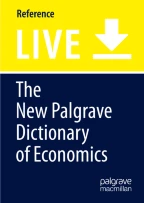
Anyone who has taught the Coase Theorem to fresh minds has experienced first hand the wonder and admiration which it inspires, yet Coase never wrote it down, and, when others try, it probably turns out to be false or a tautology. The proposition, or propositions, called the Coase Theorem was originally developed through a series of examples (Coase 1960). Like a judge, Coase steadfastly refused to articulate broad generalizations in his original paper. Like a judge’s opinion, for every interpretation of his paper there is a plausible alternative. Instead of trying to arrive at the ultimate answer, I will offer several conventional interpretations of the Coase Theorem and illustrate them with one of his examples. After more than twenty years of debate the conventional interpretations appear to have exhausted its meanings.
This chapter was originally published in The New Palgrave: A Dictionary of Economics, 1st edition, 1987. Edited by John Eatwell, Murray Milgate and Peter Newman
This is a preview of subscription content, log in via an institution to check access.